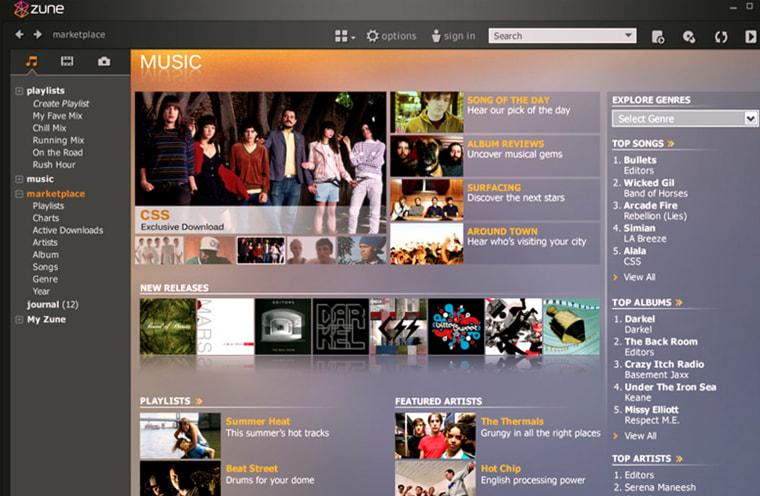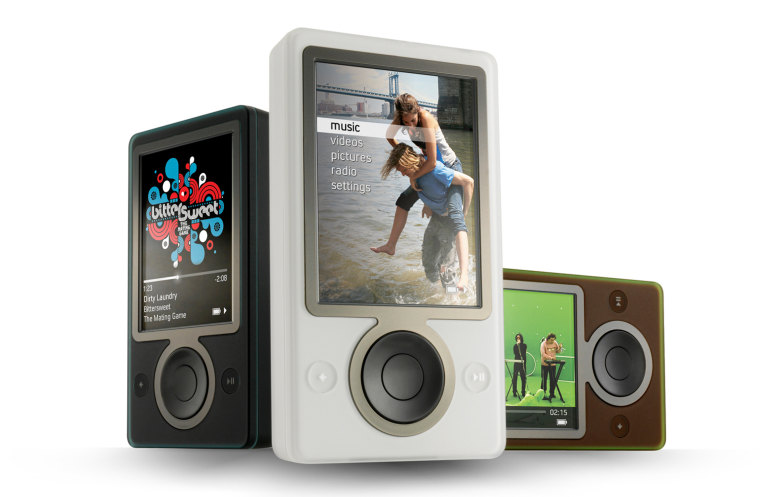I think Zune is a darned good music/video player.
It allows you to record and play back your music files in style. You can also use it to record and watch videos, listen to FM radio and view your digital photos. Its interface is intuitive and so is the Zune program that runs on your PC.
Now, want to know the Zune’s biggest problem? There are a bunch of other devices on the market that are better in many ways.
(MSNBC is a Microsoft – NBC joint venture.)
If you compare Microsoft’s new Zune device to any of the current models from Creative, Toshiba, Archos or Apple you will find differences. Some are smaller, some are sleeker, and some can handle audio or video differently. But the thing to remember is that all of the others have had a head start. Apple’s iPods have a 5-year lead. It makes sense that they're all more evolved than the first-generation Zune.
Yet, the Zune does have a lot of things going for it. Physically, it’s on the large side. Think first-generation iPod with a 30GB hard drive inside. There’s a nice looking 3-inch color screen. Zune’s interfaces (the controls you use) are very well thought out. The PC software is easy to use. And the most important thing – the Zune seems to work as advertised.
For those of you who are into numbers: Zune is 4.4 by 2.4 by 0.6 inches and weighs in at 5.6 ounces. The big, 3-inch color screen is capable of 320 by 240 pixels in either a vertical or horizontal orientation.
Zune syncs only with PCs at the moment. It handles Windows Media files, MP3 and AAC compressed music files (up to 320 Kpbs). Zune also does JPEG stills and Windows Media, Main Profile, CVR or VBR video files (up to 1.5 Mbps peak bitrates). The built-in battery pack is said to last 13-14 hours depending on what features are being used. Zune comes with a USB/PC cord charger. AC and car chargers are optional.
The one feature which sets Zune apart from its competitors is Wi-Fi. Zune users can share their files with other Zune users at a range of up to 30 feet. So sharing photos, video and podcasts is easy: You send — they watch. But if you send a song to your friend — and let's say it’s a song you’ve bought from the online Zune Marketplace — they can listen up to 3 times in three days and then either buy the song – or not listen to it again.

The Zune Marketplace is a lot like the iTunes store — only smaller — with a weirder checkout counter. Microsoft decided on some cockamamie scheme to sell songs — you buy a certain number of Microsoft Points and then spend those points on the actual music files. What’s with that?
Each song generally sells for 79-points. Each point costs you 1.25 cents. So each song comes out to 98.75-cents. I guess they can say it's cheaper than the 99-cents that iTunes charges.
Or, you can pay a monthly flat fee by buying a Zune Pass so you can download as many songs as you like and keep listening to them as often as you like on your PC and your Zune. The catch here is that you can continue to do that as long as you keep up the monthly subscription. Once you stop paying to rent the music you can't listen anymore. One month is $14.99 and three months costs $44.97!
Nice touches and nit-picking
Having an FM radio built in is a nice touch. There are still a few radio stations worth listening to in some places - although less and less each year. The Zune's FM radio has settings for U.S., Europe and Japan but was sometimes confused showing different call letters from the station I was listening to. For example, at one point, the Zune told me I was listening to a station that began with the call letter "K." No station in Manhattan begin with a "K." Also, it was sometimes tricky to adjust the FM antenna (also known as the headphone cord) for the best signal.
While I’m nit-picking, I’d like to chide Microsoft for not allowing uncompressed music files to be stored and played on Zune. The best sounding formats, uncompressed WAV and Windows Media Lossless files, are not options on the Zune. Apple gets this part right. Microsoft should update Zune’s firmware to allow these files ASAP. If I want to carry around better-sounding songs — which take up more hard drive space, and may get me to buy a second Zune — that should be incentive enough to update the software.
I’ve been playing with the Zune constantly since I’ve received it and overall can say I like it a lot. Ripping music from CDs was simple. The Zune PC program is easy to figure out and use. Same for the Zune itself. There’s no spinning wheel for navigation – but it will take you 2 minutes to become proficient on Zune’s controls. There's a large circular 5-way button, a back button to the left and a pause/play button to the right. Zune turns itself off when not in use to save battery life. There’s a lock button on the top next to the headphone jack.
Speaking of the headphones, the ones that come with Zune are worth the price you pay for them — nothing. Go out and get yourself real ones. Look for models from Shure, Sennheiser and other headphone experts. Better headphones are worth their weight in music.
Navigating around the Zune was quick – everything seems to respond much quicker than iPods and most other MP3s players I’ve had the pleasure of testing. Zune’s on-screen interface is simple to understand and easy to use. The learning curve is very quite short. Overall, Zune itself is a good device. It’s too bad it has to compete with others.
Zune comes in three colors: black (my test unit), white (very iPod) and brown (I’ll let you write in your own description). There is only one size – a 30 GB model which retails for $249.99. It’s available in stores now.
